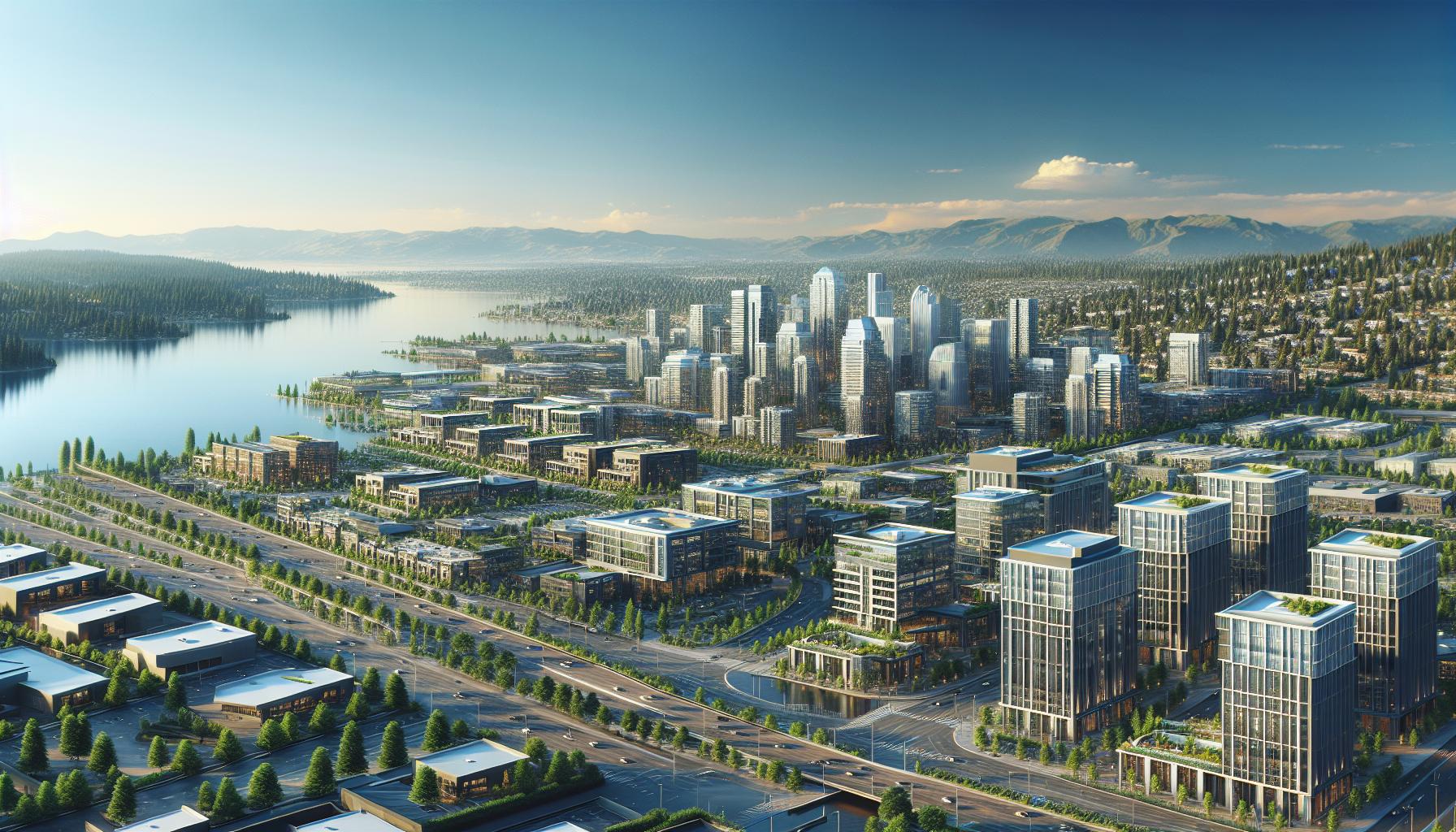As a seasoned traveler, I’ve always believed that architecture is a city’s silent storyteller. It’s like a time capsule, revealing tales of the past and visions of the future. Today, let’s embark on an exciting journey to Redmond, a city renowned for its architectural marvels.
From modern skyscrapers to historic buildings, Redmond’s architecture is as diverse as it is captivating. It’s a city that’s managed to beautifully blend the old with the new, creating a unique urban landscape that’s truly a sight to behold. So, fasten your seat belts as we delve into the architectural gems of Redmond, and explore what makes its design so special.
Exploring Redmond’s Unique Building Designs
Let’s delve into Redmond’s impressive building styles, dyed with history and washed with modernity.
Historical Landmarks in Redmond
Stepping on Redmond’s historic soil introduces us to grand landmarks that stand as testament to the city’s rich past. Redmond’s history leaps out of its silent buildings and whispers tales through its structures. Take, for example, the famed Redmond Schoolhouse. Erected in 1922, it’s a beautiful specimen of Tudor and Gothic Revival styles, showcasing early masons’ artistry. Another gem is Bill Brown Saloon, one of Redmond’s oldest surviving frame commercial buildings dating back to 1913, reverberating memories in its preserved wooden facade. These historical markers form the cornerstone of the city’s architectural anthology, grounding Redmond in deep-rooted tradition and history.
Modern Architectural Styles
The crisp lines of the city’s modern structures paint a contrasting, yet harmonious image against the backdrop of Redmond’s historic architecture. The city embraces an array of modern architectural styles — from the functional simplicity of Brutalist buildings to the sleek energy of high-tech architecture. Microsoft’s corporate buildings, for instance, embody the principles of modern architecture with their minimalist yet adaptive design. Meanwhile, the Redmond Town Center presents a range of architecture from postmodern to neofuturistic designs, a kaleidoscope of the new age. As we traverse through Redmond’s orchestrated architectural array, it becomes evident how artfully the city marries its cherished past with a visionary future.
Signature Structures of Redmond
Taking a deeper dive into Redmond’s architectural wonders, two structures primarily come to mind — Redmond Town Center and the Microsoft Campus. These signature buildings embody Redmond’s perfect balance of past, present, and future. Countless people admire them not just for their aesthetics, but also for the sensibilities they exemplify.
Redmond Town Center
Embodying Redmond’s urban spirit, Redmond Town Center emerges as a pivotal facet in the city’s architectural panorama. It’s an open-air, mixed-use development that spreads over 28 acres. Built with a combination of metals, glass, and brick, the Center captures a modern aesthetic while paying homage to Redmond’s industrial past. It’s home to more than 110 shops, restaurants, and entertainment venues which offer a spectrum of experiences for residents and visitors alike. Furthermore, its unique architectural design facilitates a bustling atmosphere that quite envelops you once you step inside.
The Microsoft Campus
On the other hand, the Microsoft Campus brings to life Redmond’s technologically advanced side. As the headquarters of one of the world’s leading technology companies, the campus spreads across an impressive 500 acres. It comprises over 80 buildings and embraces a modern architectural style embellished with glass and steel structures. Beyond its undisputed aesthetic appeal, the campus also stands as a symbol of technological innovation and global influence. Combining function, form, and meaning, the Microsoft Campus eloquently showcases Redmond’s commitment to pushing the boundaries of architectural design and technological advancement.
Architectural Influences and Trends
Redmond’s architectural marvels reflect not only the advances in technology and lifestyle, but also aims to create a mindful balance with the environment, and pay homage to the city’s rich cultural heritage. Let’s delve into these significant trends shaping the city’s architectural landscape.
Environmental Considerations
Environmental consciousness forms a crucial part of Redmond’s architectural narrative. Architects in the city use ingenious design strategies to reduce carbon footprint, such as integrating green roofs, using locally sourced building materials, and designing structures with energy-efficient windows. For instance, the Microsoft Campus incorporates smart windows that adjust tints to optimize natural light, thereby reducing the need for artificial lighting and promoting energy conservation. Furthermore, open spaces with native vegetation dotting the city help foster a connection with nature, reflecting Redmond’s commitment to preserving and promoting its natural landscape.
Cultural Inspirations
Culture serves as a profound influence on Redmond’s architectural aesthetics. The city’s structures, while celebrating modern design principles, also encapsulate its rich cultural and historical roots. Take, for instance, the Redmond Town Center. With its brick facades and timber detailing, it pays homage to the city’s industrial history whilst serving as a hub for contemporary retail and dining. Public art and installations, such as the ‘Sammamish Slough’ sculpture, tap into the cultural pulse of the city, adding layers of context to Redmond’s built environment. Recognizing these cultural inspirations provides insights into the ethos shaping architectural trends in Redmond.
Prominent Architects Behind Redmond’s Skyline
Embodying Redmond’s rich blend of history, culture, and innovation, distinct architects shape our cityscape. Their designs not only dominate the skyline but reflect Redmond’s unique soul.
Innovations by Local Designers
Local designers have gracefully intertwined the city’s past with its innovative future. Redmond’s skyline owes its unique charm to these visionary individuals.
For instance, Graham Baba Architects stands out with its emphasis on creating spaces that inspire and foster community. They’ve designed buildings like the Redmond City Hall and Bear Creek School, best known for their adaptive reuse strategies that bolster the area’s context. Their buildings stand not as monuments, but as an intimate part of the city’s fabric, enhancing Redmond’s sense of place.
Similarly, LMN Architects have made a name for themselves through their commitment to sustainability. With projects like the Redmond Technology Station, they’ve implemented green roof systems and energy-efficient design strategies, promoting both aesthetic and ecological harmony.
Award-Winning Architecture Firms
Redmond’s architectural landscape, characterized by contemporary aesthetics interspersed with traditional elements, is also home to some highly celebrated firms.
ZGF Architects, a renowned firm with an impressive list of accolades, has significantly contributed to Redmond’s cityscape. Their design for the Microsoft Campus, a balance between architectural innovation and environmental stewardship, is a cornerstone of the city’s architectural identity.
On a similar note, NBBJ has marked its presence with designs that encourage collaboration and wellness. Their work on buildings like the Lake Bill Office Campus offers inviting, light-filled spaces that spur creativity, earning them national recognition for their innovative design concepts. Through their work, they’ve enhanced Redmond’s reputation as a city conducive to creative thinking and technological advancement.
Conclusion
I’ve truly enjoyed this journey through Redmond’s architectural landscape. It’s been a pleasure to see how the city’s design has been shaped by the likes of Graham Baba Architects and LMN Architects. Their focus on community and sustainability is clearly reflected in the city’s unique skyline. The innovative designs of ZGF Architects and NBBJ have also left an indelible mark, further enhancing Redmond’s reputation for creativity and technological advancement. As we’ve seen, Redmond’s structures, from the Redmond Town Center to the Microsoft Campus, are not just buildings. They’re a testament to the city’s industrial history, its environmental consciousness, and its cultural inspirations. So next time you’re in Redmond, take a moment to appreciate these architectural gems. They’re a testament to the city’s past, present, and future.





0 Comments